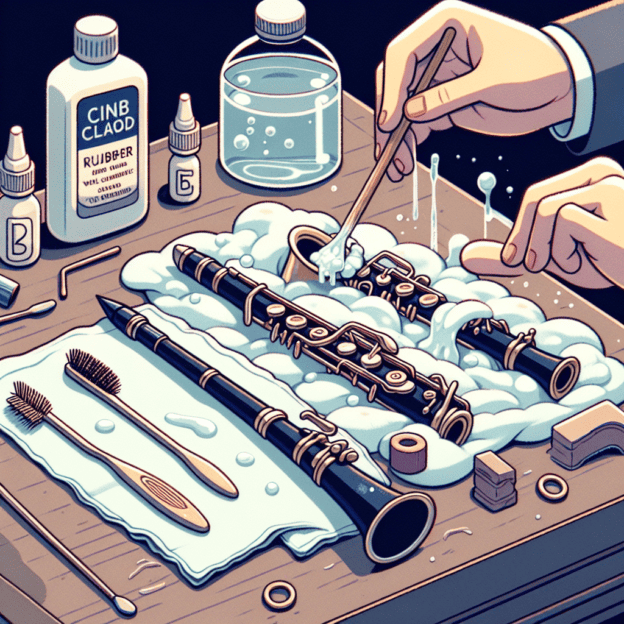The mouthpiece of your clarinet significantly influences the quality of your sound and overall playing experience. As time passes, mouthpieces can collect dust, moisture, and even bacteria, which may harm your tone and health. This guide will walk you through how to clean your clarinet mouthpiece effectively, ensuring it lasts longer and produces superior sound.
Why Clean Your Mouthpiece?
Regularly cleaning your clarinet mouthpiece is important for several reasons:
- Performance Maintenance: Dirt and moisture can block the mouthpiece, affecting airflow and tone quality. A clean mouthpiece helps produce a sharper, more resonant sound.
- Health Reasons: Bacteria can accumulate over time, potentially causing health issues. Regular cleaning helps maintain good hygiene.
- Durability: Proper cleaning and maintenance can extend the life of your mouthpiece, reducing wear and tear.
Materials You Will Need
To clean your clarinet mouthpiece, you'll need these simple tools and solutions:
| Item | Purpose |
|---|---|
| Warm, soapy water (mild soap) | For soaking and initial cleaning |
| A bowl or sink | For soaking the mouthpiece |
| A soft toothbrush or cloth | For scrubbing |
| Pipe cleaners | For cleaning hard-to-reach areas |
| Rubbing alcohol | For disinfecting |
| A soft lint-free cloth | For drying |
Step-by-Step Cleaning Process
Follow these steps to clean your clarinet mouthpiece:
- Disassemble Carefully: Gently remove the mouthpiece from the clarinet. Be careful not to use too much force that could damage the cork or tenon.
- Soak the Mouthpiece: Fill a bowl with warm, soapy water and soak the mouthpiece for about 10-15 minutes. This helps loosen any debris and grime.
- Scrub the Inside: Use a soft toothbrush or cloth to gently scrub the inside of the mouthpiece, removing any buildup. Focus on the tip where the reed connects, as this area often collects the most residue.
- Use Pipe Cleaners: Take a pipe cleaner dampened with warm soapy water and run it through the body of the mouthpiece. This helps remove any stubborn particles and ensures that the inner areas are clean.
- Rinse Thoroughly: After scrubbing, rinse the mouthpiece under warm running water to wash off any soap. Make sure there's no soap left behind.
- Disinfect: For extra cleanliness, use rubbing alcohol on a clean cloth or pipe cleaner to wipe down the mouthpiece surfaces. This helps eliminate any remaining bacteria.
- Dry Completely: Use a soft lint-free cloth to dry the mouthpiece thoroughly. Ensure no moisture remains inside, as this can lead to mold or unpleasant odors.
- Reassemble the Clarinet: Once the mouthpiece is completely dry, carefully reattach it to the clarinet, making sure it fits snugly without forcing it.
Tips for Efficient Mouthpiece Maintenance
- Daily Cleaning: Get into the habit of rinsing your mouthpiece with water after each playing session to remove saliva and moisture.
- Weekly Deep Clean: Try to perform a thorough clean of your mouthpiece once a week, especially if you play daily.
- Regular Inspections: Frequently check for signs of wear or cracks. If you notice any issues that need repair, consult with a professional technician.
- Proper Storage: When not in use, keep your mouthpiece in a protective case to prevent dust buildup and physical damage.
Material Considerations
Clarinet mouthpieces are typically made from various materials, including hard rubber, plastic, or wood. Each type requires similar care but has unique qualities:
- Hard Rubber Mouthpieces: Known for their warm tone and durability, these mouthpieces need regular cleaning to maintain their performance.
- Plastic Mouthpieces: More affordable and resistant to moisture. They're easier to maintain but may not produce the same tonal richness.
- Wood Mouthpieces: Often found on specialty instruments; these are sensitive to humidity changes and need careful moisture management.
The Impact of Quality Mouthpieces
Choosing high-quality mouthpieces can make a significant difference. Brands like Martin Freres offer instruments that improve your playing experience, delivering a crisp, vibrant sound. Quality mouthpieces are usually more durable and provide consistent response.
By following these clarinet mouthpiece cleaning tips and best practices, you'll keep your gear in top shape and play with confidence, resulting in better sound and performance. So, take that extra bit of time for care, and enjoy all the benefits of a clean and well-maintained mouthpiece!







